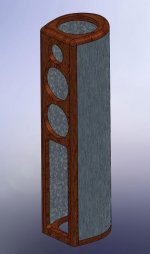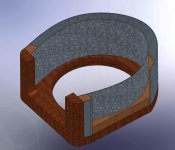OK, fair enough.
But this is quite interesting:
I always thought, for most of us (I mean, speaker builders), the cabinet (mostly wood) work is the difficult and time consuming portion. Just like the metal work of the cases to the amp builders -- how I hate drilling and filing the case for a pre amp! Oh well, maybe it's just me.
As to the OB "issues", those circuit things are actually easy to deal with. And I can't think of anything significant you'd have to "pay" for OB speakers.
OK, I'm done on OB and won't persuade you any further.
Anyway, please do update here for your metal work, I'm looking forward to see it. One last thing, would you consider placing the side walls inside the frame? I just love to see the exposing skeleton
But this is quite interesting:
JoeM said:
...but OB has it's own set off issues that Im not prepared to deal with and pay for.
I always thought, for most of us (I mean, speaker builders), the cabinet (mostly wood) work is the difficult and time consuming portion. Just like the metal work of the cases to the amp builders -- how I hate drilling and filing the case for a pre amp! Oh well, maybe it's just me.
As to the OB "issues", those circuit things are actually easy to deal with. And I can't think of anything significant you'd have to "pay" for OB speakers.
OK, I'm done on OB and won't persuade you any further.
Anyway, please do update here for your metal work, I'm looking forward to see it. One last thing, would you consider placing the side walls inside the frame? I just love to see the exposing skeleton
Using a lower mass material just fills the space but does not guarantee acoustical energy absorption.
Mostly true, but some of the newer pre-expander Urea-Formaldehyde foams have great rigidity and integral sound absorbing proprieties.
I'm not advocating them, just said that it sounded interesting.
Urethane board has been used for example in constrained layer construction
CLS said:-- how I hate drilling and filing the case for a pre amp! Oh well, maybe it's just me.
Oh no! You are far from alone in that.
Sand. sand is the way to go.
Hi JoeM
What are your cabinet dimensions internal,you might be able to get RHS or SHS in the right size for the inner shell .
In SHS you can get 300mmx300mmx6mm square box.
Or use channel and weld together .
http://www.moorabbinsteel.com.au/channel.php
Cheers
What are your cabinet dimensions internal,you might be able to get RHS or SHS in the right size for the inner shell .
In SHS you can get 300mmx300mmx6mm square box.
Or use channel and weld together .
http://www.moorabbinsteel.com.au/channel.php
Cheers
56oval, thanks for the link but square is SO yesterday 
Moondog, I have some urethane left. Im thinking some thin polycarb sheet formed similar to these ovoid with say 30mm cavity and sandwich of the same for top and bottom in a bookshelf would be a worthwhile test. All of 2 hours? And light!
When you say stabilized, you mean mixed in? Would this not have a negative effect regards deadening?
CLS,
You dont need to convince me on OB I WILL be doing it eventually It's the power handling and room placement issues that Im not really looking forward to. Also cost. If Im going to do it it's worth doing right, ie Orions.
It's the power handling and room placement issues that Im not really looking forward to. Also cost. If Im going to do it it's worth doing right, ie Orions.
picowallspeaker,
Have you any info/links on all things 'inertial characteristic's regarding sand or other materials?
I do worry a little about how it settles out after years, Im tipping larger particles sink eventually?
Moondog, I have some urethane left. Im thinking some thin polycarb sheet formed similar to these ovoid with say 30mm cavity and sandwich of the same for top and bottom in a bookshelf would be a worthwhile test. All of 2 hours? And light!
When you say stabilized, you mean mixed in? Would this not have a negative effect regards deadening?
CLS,
You dont need to convince me on OB I WILL be doing it eventually
picowallspeaker,
Have you any info/links on all things 'inertial characteristic's regarding sand or other materials?
I do worry a little about how it settles out after years, Im tipping larger particles sink eventually?
Attachments
This cut away shows the bottom cross section. The top would be the same. All put together with liquid nails. No fastners needed.
The large square hole in the front and the round holes in the top and bottom plates are to have a sheet metal cover rebated inside and out and filled with sand.
I think any sheet metal about 0.5mm would follow the horses shoe mdf 'plug' just fine. I've shown brushed stainless on the outside and galvanized inside.
The large square hole in the front and the round holes in the top and bottom plates are to have a sheet metal cover rebated inside and out and filled with sand.
I think any sheet metal about 0.5mm would follow the horses shoe mdf 'plug' just fine. I've shown brushed stainless on the outside and galvanized inside.
Attachments
filled a pair of speaker stands with dry sand but stabilized
I think the stands and speaker walls may have different needs, but it did keep the sand in position at the bottom, more importantly it didn't leak out over time.
They were VERY dead and solid though.
I have another pair of "Apollo" stands with a 75mm tube upright perhaps I should experiment again.
Which urethane? the diisocyanate type? that can be hazardous so use plenty of positive ventilation. I still one 500ml can of pre-mix left myself
Possibly yes, there may be less friction between grains of sand which I think is the deadening mechanism in this form of construction apart from the obvious extra massWould this not have a negative effect regards deadening
I experimented with mixing chopped strand fiberglass with foaming resin once, for an automotive application; the foaming action carries the glass fibre to the outside seemingly making the skin stronger and more rigid.
Those experiments were done many years ago at "Bostik" using Freon 113 and isocyanate based foams so may not translate to modern materials, those were the days; we used to wash our hands in the stuff; decant it from stacked 200litre drums and carry it around in open buckets.
Excerpts from "Lautsprechergehause-baubuch" by Hans Herber Klinger ,1977
insonorisation:
...peaks...dips...non-vibrating-stop-the-oscillations...brick construction (!!!)no possible-better using wood,internally braced with bitumen impregnated foils...Tereform,Teroson (worse).
A good way of isolating a cabinet ,making it proof from oscillating and inert to acoustic waves ,is to build a sandwich structure.Using MDF panels,allow 3-4 cm (!!!)between them and fill with dry fine sand.It has to be dry,otherwise when everything is well closed it will expand causing bumps or even explode (sic.).
The sandwich principle is good indeed ,particularly against vibratory oscillation and sound-proof.On the other side the issue is that even little boxes , from 40 to 60 liters ,will weight a lot and will be difficult to move. But acoustic quality is substantially better than other methods .
The importance of being sound-proof for a loudspeaker cabinet and the ability of loudspeakers to produce an uncolored sound , has been acknowledged only lately these years .Unfortunately it is not well acquainted enough . the non satisfying behavior of many boxes is due mostly to this.
absorption: use lot of mineral wool in your vented boxes !!!!!!!!
insonorisation:
...peaks...dips...non-vibrating-stop-the-oscillations...brick construction (!!!)no possible-better using wood,internally braced with bitumen impregnated foils...Tereform,Teroson (worse).
A good way of isolating a cabinet ,making it proof from oscillating and inert to acoustic waves ,is to build a sandwich structure.Using MDF panels,allow 3-4 cm (!!!)between them and fill with dry fine sand.It has to be dry,otherwise when everything is well closed it will expand causing bumps or even explode (sic.).
The sandwich principle is good indeed ,particularly against vibratory oscillation and sound-proof.On the other side the issue is that even little boxes , from 40 to 60 liters ,will weight a lot and will be difficult to move. But acoustic quality is substantially better than other methods .
The importance of being sound-proof for a loudspeaker cabinet and the ability of loudspeakers to produce an uncolored sound , has been acknowledged only lately these years .Unfortunately it is not well acquainted enough . the non satisfying behavior of many boxes is due mostly to this.
absorption: use lot of mineral wool in your vented boxes !!!!!!!!
- Status
- This old topic is closed. If you want to reopen this topic, contact a moderator using the "Report Post" button.
- Home
- Loudspeakers
- Multi-Way
- Welded steel frame sand filled enclosure

